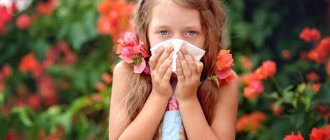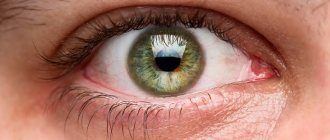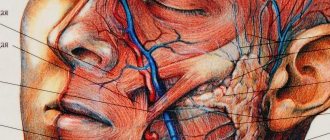Infectious skin diseases
Red, scaly spots on the body may indicate a viral or bacterial infection has entered the body. Most often, skin rashes are symptoms of the following infectious diseases.
- Shingles. It is caused by the herpes virus type III, which also causes chickenpox. A sick person develops red spots on the body that peel and itch. Skin formations are small in size, but if they spread strongly, they can merge into one large spot. Small yellowish bubbles appear on the spots; after a few days they burst, and the skin in their place quickly dries out. The virus most often affects the torso, but can also affect the face in the trigeminal nerve area.
- Sycosis. Chronic inflammation of hair follicles affected by staphylococcal infection. The disease appears only in people with weak immunity; the source of the inflammatory process can be any microcrack in the skin or a scratch after shaving. In men, pathogenic bacteria primarily affect the mustache and beard, in women - eyebrows and eyelashes. The infection rarely affects pubic and axillary hair. Sycosis causes redness of the skin around the hairs; if left untreated, the disease quickly spreads to healthy areas of the skin.
- Tick-borne borreliosis. The causative agents of the disease are bacteria of the genus Borrelia, transmitted by ticks. After an insect bite, pathogenic microorganisms penetrate the skin and cause an inflammatory reaction. A red, blurry spot forms at the site of the bite, dividing into several ring-shaped layers. The infected person feels unwell and experiences pain.
Treating Skin Spots
In treatment, it is important to identify the cause and select the most effective dosage and period of taking the drugs. Today, therapy is based on 3 methods:
Today, therapy is based on 3 methods:
- Antibody-based drugs for infection.
- Gene correction.
- Immunomodulatory drugs.
Let's celebrate! In addition, you should lead a healthy lifestyle, take care of personal hygiene, and adhere to a strict vitamin diet.
Drug treatment
For quick treatment, elimination of the disease and prevention of complications, the course of therapy should be carried out under the supervision of the attending physician.
As a local treatment, dermatologists often prescribe gels and creams such as Batrafen or Mycoplast.
More serious therapy, depending on the causes of red spots, is as follows:
- To reduce manifestations and discomfort such as itching and swelling, antihistamines are prescribed, for example, Tavegil, Suprastin, Loratadine.
- If inflammation, irritation appears on the skin, or the skin begins to peel, tar or sulfur-salicylic ointment helps.
- A bacterial infection in the body is eliminated with strong antibiotics.
- If an allergic reaction to a tick bite develops, Amoxicillin, Extencillin, and Ceftriaxone help the insect well.
- The drug "Acyclovir" helps in the treatment of herpes zoster and lichen.
- Additionally, in the treatment of lichen, it is necessary to use physiotherapeutic procedures, vitamin complexes, as well as individually selected corticosteroids.
- For fungal infections, dermatologists and infectious disease specialists prescribe the drugs “Lamisil”, “Irunil”, “Fluconazole”, “Batrafen”.
Traditional methods
Areas of affected skin constantly need to be softened and disinfected; healing herbs and herbs are used for this.
The following recipes can help:
- Ordinary salt. A finger moistened with saliva is dipped in salt. This salt should be applied to areas with lichen. One procedure is enough to experience a noticeable improvement in your condition. The rash then disappears after 3 days, use no more than 7-10 days. The recipe is approved for use by patients of any age.
- Raisin. Rub it on the affected areas, after cutting lengthwise. The course is carried out until the symptoms disappear; it can be used for infants and children of any age.
- Garlic tincture or juice is used to treat a skin defect. It is necessary to dilute 100 g of garlic in 0.3 ml of vodka (alcohol), the procedure is carried out 2 times a day. Suitable for children over 3 years old, monitor the reaction, contraindications - allergies.
- Fresh aloe juice. Cut the leaf and smear the affected area 3 times a day until complete recovery. Can be used for newborns.
It will take quite a long time to completely get rid of the disease. Most often, it happens that the child’s skin is already clean and no lesions are noticeable, but the disease is still present, and if treatment is stopped, it will soon reappear.
Therefore, it is imperative to adhere to all the dermatologist’s recommendations throughout the entire prescribed treatment period.
Why should you go to a dermatologist?
Visual self-diagnosis is quite unreliable; you can mislead yourself and begin long-term and hopeless treatment of symptoms. Sometimes you can accidentally guess, and then the treatment will work, but is it worth making a lottery out of your own health?
To diagnose fungal diseases, for example, a comprehensive examination of scrapings is carried out under a microscope, and the material is also checked in the rays of a fluorescent lamp with a Wood filter. In severe cases, a culture of the fungus obtained by scraping is sown in an artificial nutrient medium - this makes it possible to determine the type of pathogen with a high degree of accuracy and select an effective treatment.
Yes, at first glance, a white spot with a red rim on the skin resembles some types of lichen; sometimes young psoriatic plaques look like this. But the final diagnosis and selection of medications must be made by a dermatologist.
Etiology
The formation of brown spots is the result of increased production of melanin in epidermal cells. Melanin is a special pigment that is produced in the upper layers of the skin in order to deeply protect it from damage and the harmful effects of ultraviolet radiation.
But the development of this symptom can be provoked by the following pathological processes in the body:
- Tinea versicolor. Light brown spots on the body, which at the initial stage of formation are small in size (up to 2 cm in diameter) and have a fuzzy edge line, moderate itching and peeling in the center, are considered a sign of lichen versicolor. The causative agent of the disease is the fungus Malassezia furfur. Such spots are localized in the back, neck and arms, less often found on the stomach, legs and groin. People with excessive sweating are most susceptible to contracting tinea versicolor. The disease can also develop against the background of hypothermia and a sharp decrease in immune defense.
- Pigmented nevi. The most common type of accumulation of skin melanin is moles (pigmented nevi). Such neoplasms are usually small in size, round in shape, and have clear edges. Moles are often flat, do not rise or protrude slightly above the surface of the skin. The danger of such skin growths lies in the possibility of their degeneration into a cancerous disease - melanoma.
- Hormonal imbalance. The cause of pigmentation on the skin can be a hormonal imbalance (in adolescents during puberty, in pregnant women, etc.). Typically, such a skin reaction is observed under the mammary glands, on the face and in the chest area. Pigmentation due to hormonal imbalance manifests itself in the form of small light brown spots, which disappear without a trace after the balance of hormones in the body is normalized.
- Lentigo. Dark, smooth, small (up to 2 cm in diameter) oval or round formations may be a sign of lentigo. Such benign growths occur at any age (even in the first year of a newborn’s life). Typically, the process of their development lasts up to 30 years. Lentigo spots are most often localized in the neck, face, legs and arms. The reasons for their formation are considered to be hereditary predisposition, frequent skin injuries, the presence of infectious lesions of the body, hormonal imbalance, thermal and chemical exposure.
- Chloasma. Brown spots on the skin often appear due to malfunctions of the ovaries (in women), liver and adrenal glands. Under the influence of such internal imbalance, chloasma develops, a pathology associated with impaired melanin production. Chloasma lesions can be of different sizes and shades (dark brown, yellowish and even black). They are localized on the forehead, eyelids and temples in men, in the area of the nipples and external genitalia in women. This rash is not accompanied by peeling of the skin.
- Freckles. A hereditary disease that causes increased pigmentation when exposed to sunlight can cause brown spots to appear on the skin. The first signs of freckles usually become noticeable between the ages of 6 and 10 years. At the same time, small (the size of a pinhead) inclusions of a yellowish-brown color form on the skin, which increase in size in the spring-summer period and fade in the fall.
- Melanoma. The most dangerous cause of brown spots on the body is melanoma - a malignant neoplasm that develops from age spots, which looks like a dense nodule with convex parts. Melanoma can reach from a few millimeters to 3 cm in diameter. Sometimes its appearance is accompanied by itching and the formation of bleeding erosions in the affected area. At the initial stage, such a spot may resemble a mole, but as the disease progresses, it metastasizes to the vessels, lymph nodes, and other organs and tissues.
To prevent the development of dangerous complications, it is necessary to pay attention to timely treatment of skin tumors
Etiology of manifestations
The etiology, or causes of red spots on the back, is very diverse. Any skin diseases, be it pimples, blackheads, warts, itching and inflammation on the skin, always not only create discomfort, but are also signs of serious diseases that begin to develop in our body.
The skin, like a litmus test, reflects that negative processes are occurring in the body. And there are a lot of causes of skin diseases, the main ones are: diseases of internal organs, viruses, infections, fungi, disorders in the endocrine system, psychological problems, neuropathologies.
So, a rash or small red spots may appear due to diseases of the digestive tract, in particular, become a manifestation of:
- pancreatitis,
- gastritis,
- ulcers.
Inflamed internal organs can declare their pathology this way when there is any infection in the human body:
- in the genitourinary system;
- in the respiratory system;
- in the biliary system (biliary tract, liver);
- in the gastrointestinal tract.
If a red spot appears on the back, then negative processes develop in the body. To identify the onset of the disease, it is necessary to urgently consult a doctor to diagnose and determine the etiology of the disease.
The main and common cause of redness on the back is an unbalanced, unhealthy diet. Small red spots can appear due to poor nutrition, when a person abuses:
- fried;
- sharp;
- sour;
- salty;
- smoked;
- canned;
- carbonated drinks;
- sweet.
Then inflammatory processes in the internal digestive organs begin in the human body: stomach, pancreas; intestines. The acid-base balance is destabilized, which causes increased secretion of hydrochloric acid, which can provoke a reaction on the skin such as red spots.
But the following skin diseases also give such a reaction:
- psoriasis;
- acne;
- fungal skin diseases;
- vitiligo;
- eczema;
- seborrhea;
- dermatitis;
- lichen;
- papillomas, condylomas.
You can determine individually which skin disease manifests itself as red spots on the back only by contacting a dermatologist.
Additional reasons
Redness on the back of an adult can also be caused by a burn or frostbite. Preventing such redness is simple - you need to warm yourself in cold weather and protect yourself in hot weather. For these types of pathologies in the initial stage, it is enough to use external agents and preparations in the form of sprays, ointments, gels and creams for treatment.
A large red spot can also appear due to nervous disorders. Many skin diseases are provoked by stress, nervous diseases, overwork, constant irritation and anxiety. The location can be anywhere - on the face, neck, abdomen, limbs, lower back, back. Such diseases include neurodermatitis, atopic dermatitis and psoriasis.
The people were taken aback! Joints will recover in 3 days! Attach...
Few people know, but this is exactly what heals joints in 7 days!
Carrying out therapeutic therapy
When it is confirmed that a red spot with a white center is of fungal origin, antifungal drugs are used. This may be Lamisil, Clotrimazole (effective in the early stages of the formation of the disease). In case of a complicated course of the pathological process, it is allowed to prescribe systemic treatment - a combination of local and general drugs. Fluconazole and Clotrimazole may be prescribed, which have minimal negative effects on the liver.
If the red spot is of infectious origin, then antibacterial drugs are prescribed.
If elements of the rash appear due to allergies, then taking antihistamines is justified.
Treatment
Before you begin treatment on your own, you must consult a doctor. Only he will be able to correctly diagnose the disease and select adequate treatment.
At home, it is best to carry out preventive measures that will protect the body from various skin diseases. To do this, you need to lead an active lifestyle, minimize bad habits, consume more vitamins, and also take care of personal hygiene.
Autoimmune diseases differ in nature and must be treated differently. The main methods of treatment today are the anti-inflammatory system, as well as the use of drugs that can suppress the immune system.
The latter method works well in treatment, but exposes the person to great risks. The fact is that the body is greatly weakened and is therefore much more susceptible to severe infections. For proper treatment, constant monitoring by the attending physician is necessary.
Today, three main methods of treating this pathology have been developed:
- Gene correction;
- Antibody-based drugs;
- Medicines that regulate the functioning of the immune system.
As for the treatment of lichen, there is no special treatment. If itching is observed, a dermatologist can prescribe antihistamines, as well as various gels, in particular, sulfur-salicylic and sulfur-tar ointments. They not only relieve the symptoms of inflammation, but also allow you to quickly get rid of spots on the body.
Fungal infection can be treated with various gels, drugs that are taken orally and support the immune system, as well as with the help of folk remedies. Dermatologists note that ureaplast mycoplast, as well as batrafen, show their effectiveness well. These drugs come in the form of a gel, which is applied evenly over the entire affected area.
Are red moles dangerous?
Signs to pay attention to if small red moles appear:
- Color. If it is uneven and begins to change, this is a reason to visit a doctor.
- Inflammation around the formation, that is, redness in the form of a halo around the mole.
- An increase in the size of the mole or its thickening.
- The appearance of cracks and ulcers on the body of the mole.
- Hair loss if it grew from a mole.
- The appearance of itching, burning or tingling in the place where the mole is located.
- A change in the edges of the nevus also indicates that it is time to visit a specialist.
An accurate diagnosis can be made by a dermatologist or oncologist, and you can and should turn to them for help. Nevi are not dangerous as long as they are in a stable condition, in which case you can wait to see a doctor.











